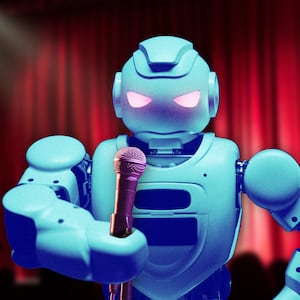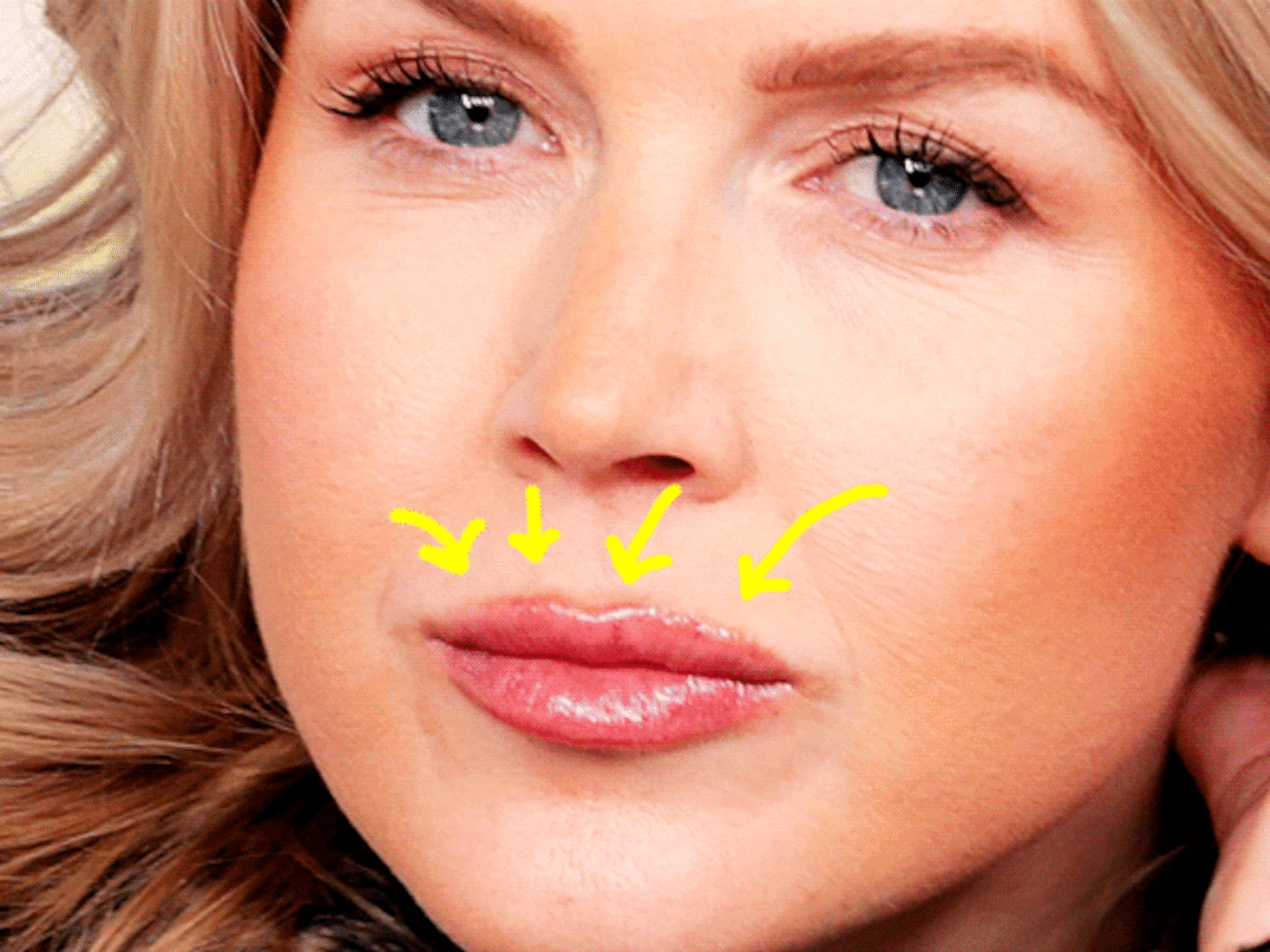For the past five years, Joe Toplyn has been trying to build a robot that’s as funny as he is. It’s challenging, in part, because he’s a pretty funny guy. The Harvard Lampoon alum worked for years as the head writer for the likes of David Letterman and Jay Leno, garnering a small collection of Emmys along the way, and even went on to write and produce for the show Monk. Years later, he wrote a book about what he learned in show business called Comedy Writing for Late-Night TV, and taught the craft of writing jokes to aspiring comedy writers in New York City.
Then one day, he tuned into the game show Jeopardy where he watched IBM’s Watson clean house against human contestants. Having studied engineering at Harvard, Toplyn’s curiosity was piqued.
“I read some research papers about how Watson worked and looked at its flowcharts,” Toplyn told The Daily Beast. He learned that the way Watson worked to dominate the quiz show was a lot like the way a joke is formed. It analyzes the prompt, breaks it down into its key elements, and eventually synthesizes what it “knows” about those elements into an answer.
“Well, that’s like choosing the topic handles when writing a joke,” Toplyn explained. “So I developed a sense that if Watson can do that, then there may be a way for machines to execute these steps in the joke writing algorithms.”

Joe Toplyn (left) discusses a comedy piece backstage with a former comedian (right) in 1995.
Joe ToplynThis was all happening in 2011. And since then, the world of AI has exploded. In the past few months alone, he said he’s seen a “quantum leap” when it comes to the power and sophistication of AI—particularly in large language models (LLM) like OpenAI’s ChatGPT. Following its release in Nov. 2022, ChatGPT has laid the foundation for the type of hype and fervor for a new piece of technology the world hasn’t seen since, arguably, the release of the iPhone or the launch of Facebook. Even the likes of Google are struggling to play catch up as LLMs begin to proliferate and potentially upend entire industries like law, copywriting, and coding.
Now, Toplyn and many others believe that LLMs could even lay the groundwork for the development and launch of humor bots, and other AI capable of crafting everything from jokes, to funny tweets, to even entire sketches. It’s a bold and incredibly elusive goal given the fundamentally human nature of humor, but not all that surprising given the many attempts to create a comedy bot being over the past several decades. If Toplyn and others succeed, however, they could lead to the kind of disruption that would change the course of professional comedy everywhere—or at least, that’s one potential punchline for it.
The Rise of the Humor Bot
The idea of making a robot that’s capable of humor isn’t a new one. We can trace its origins conceptually back to science fiction shows and movies like Lost In Space, Star Trek, and Doctor Who. One of the earliest attempts at an automated joke-writing system is the Joke Analysis and Production Engine (JAPE) created by AI researchers Kim Binsted and Graeme Ritchie of the University of Edinburgh in 1994.
The system was hand-coded and relatively rudimentary when compared to the sophistication of today’s GPT-4, but was still capable of churning out high-quality puns and riddles you might find in children’s joke books: “What kind of pig would you ignore at a party? A wild bore”; and “What kind of tree could you wear? A fir coat.”
And so for years, humor bots remained mostly in the range of simple wordplay and puns like JAPE. In 2013, a separate group of University of Edinburgh computer scientists created a bot that could make funny “I like my X like I like my Y” analogies like “I like my relationships like I like my source: open” or “I like my coffee like I like my war: cold.”
We’ve seen these types of simple joke bots become more proliferated with the rise of social media—particularly with Twitter bots like @dadjokeAPIbot, which churns out groan-worthy puns like “R.I.P. boiled water. You will be mist.” or the surreal @headlinertron, which pumps out surreal borderline inspired jokes from a faux-headliner at a comedy club like this:
But, of course, comedy isn’t just puns (or whatever Headlinertron is doing). Jokes can be incredibly complex and sophisticated. JAPE can only scratch at the surface of the many many layers of social, historical, or even personal context—along with wordplay and timing—that can go into a supremely good joke. It’s something that people have attempted to wrap their heads around for as long as we’ve been laughing.
“As a field, humor studies have been around for thousands of years,” Tony Veale, an AI and computational creativity researcher at University College Dublin and author of Your With Is My Command: Building AIs with a Sense of Humor, told The Daily Beast. “Aristotle wrote about humor. A large number of philosophers have opined on humor.”
“But in an AI, it’s a text understanding and generation problem,” he added. “Can we detect when someone is being humorous or humorously insincere? Can I get this machine to generate stuff that will tickle a lot of people's funny bones?”
But there is pretty much one thing that most all definitions of a good joke have in common: they have to surprise you. “We laugh when we’re surprised that an incongruity turns out to be harmless,” Toplyn explained. That’s essentially what is at the heart of all comedy. Something surprises us and, if that thing doesn’t hurt us, we laugh.
That’s easy enough for us to wrap our human minds around. After all, people start laughing and understanding humor soon after they’re born (there’s a reason babies love peek-a-boo after all). But for a robot, it’s much more difficult. There’s so much complexity of language involved in being funny and creating that sense of surprise and incongruity that the task of creating a bot that’s as humorous as a human becomes something much more serious and difficult.
Or, at least it seemed that way before ChatGPT came along.
ChatGPT to ChatLOL
OpenAI’s incredibly popular chatbot has a lot of people asking what jobs will get automated first, what industries will disappear, and how soon artificial general intelligence will arrive—just to name a few things. For folks like Toplyn and Veale, though, it made the task of creating a robot that’s capable of producing truly human-like comedy much, much more realistic.
Even up to a year ago, Veale wouldn’t have thought that bots would have been able to produce jokes and comedy completely like a human. Now, with the release of LLMs like Bard and GPT-4, he’s not so sure.
“These models have become more complex, and we see more emergent behavior from them,” Veale explained. “These are behaviors that we couldn’t have predicted and seem out of the scope of a language model.”
Toplyn, on the other hand, has been incredibly bullish on comedy bots. So much so that he eventually took his curiosity of computational humor and took it a step further: He purchased his own patents for a comedy bot dubbed Witscript, which he claims is “the first artificial intelligence to ad-lib real jokes.”
Using OpenAI’s GPT-3 large language model, the bot is capable of processing any prompt, ranging from news headlines to questions like “Who would win in a fight: Mike Tyson or the Rock?”; and then churn out the type of jokes that you might Stephen Colbert or Jimmy Fallon say on their late night monologues—or at least something close to them.

Witscript can be used as a tool for comedians and comedy writers to help in their joke writing process.
Joe ToplynIn a demo for The Daily Beast, Toplyn used the prompt “Donald Trump is being investigated for paying Stormy Daniels hush money.” Topical, salacious, and including Donald Trump. It had all the ingredients for something you’d hear in the late night circuit today. After a few seconds, Witscript gave four responses:
- What’s the big deal? He pays hush money to all his mistresses!
- That’s not hush money, that’s just his tip!
- Why did Trump pay Stormy Daniels hush money? Because he’s a Cohen man!
- If the payment was hush money, I’m not sure why he’s in such an embrace with her.
The bot even selected its favorite of the four. In this case, it was “What’s the big deal? He pays hush money to all his mistresses!” Of all the responses, this is probably the one that would be the closest to being television ready. And even if it’s not, argued Toplyn, there’s still a lot of value for a humor bot.
“You could look at this as your joke writing assistant. This is like a comedy writers’ room,” Toplyn said. “The head writer says, ‘Oh, we need a joke about Stormy Daniels’ hush money’ and the writers pitch jokes. Some of them are going to be crummy. Some of them will almost be a joke, in which case some other writer can pick it up and fix the joke.”
While Witscript currently runs on GPT-3.5, Toplyn said that once GPT-4 becomes available to him as a developer, he’s going to implement it into the software and, hopefully, get even funnier jokes from the system.
In his mind, Toplyn believes that a tool like this could not only be invaluable for, say, the writers’ room of Fallon’s Tonight Show, but it could be a way of democratizing humor and joke creation in a way that we have never seen before. After all, not everyone can make great jokes—but you might need them for your script, or tweet, or presentation at work. A generalized humor bot could be there to help give the tools to comedy to the unfunny masses.
Or, take it a step further: Maybe you want to have your own comedy show on YouTube or TikTok, but you don’t have the type of money coming in from network television advertising dollars. “What that’s doing is providing comedy to someone who otherwise could not afford to hire a human writer or don't have access to comedy any other way,” Toplyn said. “They can't write jokes or hire a professional writer—but they want jokes.”
He concedes that there will likely always be a need for a human in the loop. “I don’t believe in the foreseeable future that humans are going to be taken entirely out of the equation because I think there still has to be a curation,” Toplyn said. “This version of Witscript, at least, could make jokes that could be on a late-night show, but you need a human eye to say, ‘Yeah, that’s the one that Colbert would deliver and the audience would love it.’”
Of course, as with anything that’s AI related—especially when it comes to generative AI that can churn out award-winning art or realistic conversations with human users—a humor robot is going to ruffle some feathers. After all, if a robot is capable of producing something so fundamentally human as comedy and laughter, what does that mean for the rest of us?
When asked if there was anything else Toplyn wanted people to know about comedy, robots, and building comedy robots, he decided to turn to Witscript for an answer by asking it: “What questions might readers of The Daily Beast have about AI-generated jokes?”
Among its four responses was the beautifully appropriate joke, “Why did the AI-generated joke cross the road? To get to the other side of humor!”
“Kind of a little zen,” Toplyn noted. “Because, in this work, that’s exactly what we’re doing: We’re getting to the other side of humor.”







